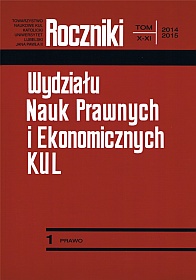The principle of separation and balance of powers in Polish constitutional law: A historical view
Abstract
In the 18th century, the doctrine of separation of powers was established as a remedy for tyranny. The reception of the principle of separation and balance of powers in Poland was very fast, relative to its formulation. This happened together with the establishment of the Third of May Constitution. The Second Republic of Poland had two constitutions, apart from provisional acts of constitutional rank. The first, March Constitution directly referred to the principle of separation of powers. The other, April Constitution was a contradiction of the former. The political system of the PRL was without any doubt a totalitarian one. The Third Republic of Poland returned to a system based on the separation of powers, especially in the period when it regained full sovereignty and it quickly returned to building its political system based on this very principle.
References
Izdebski H., Historia myśli politycznej i prawnej, Warszawa 2001.
Kelly J. M., Historia zachodniej teorii prawa, Kraków 2006.
Kowecki J., Konstytucja 3 maja 1791. Statut Zgromadzenia Przyjaciół Konstytucji. Warszawa 1991, p. 98.
Monteskiusz [Monteskieu Ch. M. de], O duchu praw, Kęty 1997.
Sarnecki P., Prawo konstytucyjne RP, Warszawa 2008.
Copyright (c) 2015 Roczniki Wydziału Nauk Prawnych i Ekonomicznych KUL

This work is licensed under a Creative Commons Attribution-NonCommercial-NoDerivatives 4.0 International License.

